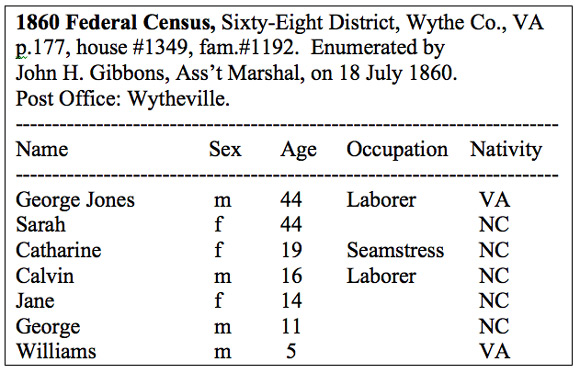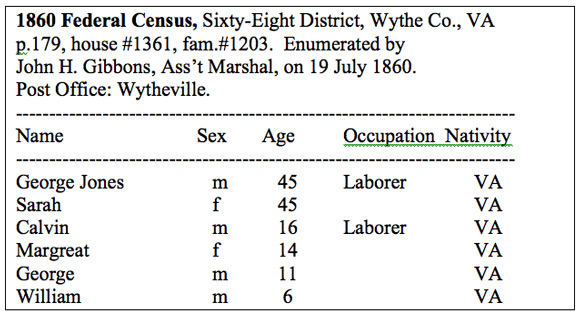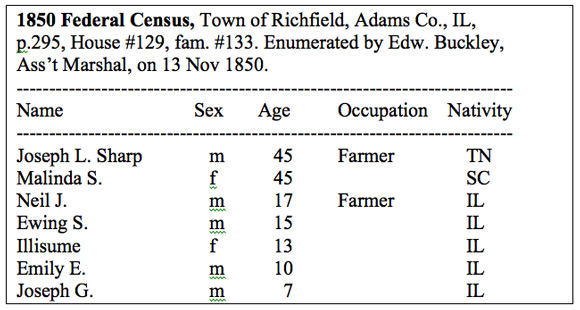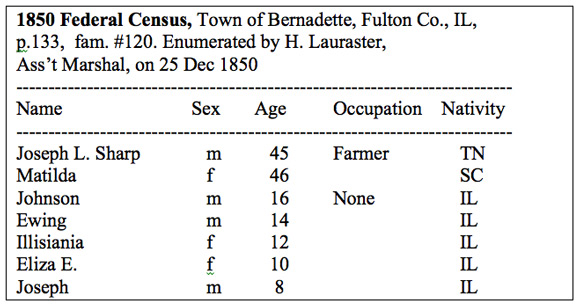The following article was wriiten by my friend, Bill Dollarhide:

Dollarhide’s Rule #9: An 1850 census record showing twelve children in a family proves only that your ancestors did not believe in birth control.
Census records provide researchers a primary source of genealogical evidence. The fact that names of people and relationships are listed in certain census schedules is all that is needed to make them our most important sources for finding our ancestors. But, too often, genealogies are prepared just from census records and no other source.
As useful as census records are to genealogists, the real importance should be the clues they provide to access more records concerning our ancestors. For example, a census record may be the only way a genealogist learns of the county of residence for an ancestor. And, with that information, much more can be learned about a person from county records located in a courthouse, such as births, deaths, marriages, probates, or land records. The census records lead us to the place on the ground where more genealogical evidence can be found. That is the most trustworthy aspect of census records — they are place finders.
Nevertheless, census records are widely used by genealogists to prepare a record of one’s ancestry. But, census records, unfortunately, are prone to errors. If so, what information can you trust? And, if all you have as evidence of a family is what you have found in a census record, have you really proven anything?
Here are some things to consider when using census records, and areas where mistakes are prevalent.
Wrong Spelling
Probably the most common mistakes in census records are the spelling of names. It is estimated that between 60 and 75 percent of the U.S. Population in 1790 could read or write. That means that the spelling of a person’s name in a 1790 census record may have a 25-40 percent chance of being in error. The census taker (who presumably could read and write) wrote down the names of the heads of household based on what he heard them say. If the spelling of a name is terribly important to you, don’t expect census records to be very useful, because you may never find the name spelled the way you think it should be. The fact that names were spelled phonetically by early census takers means you have to think of ways to misspell a name before ruling out someone as the right person. Therefore, I accept any American spelling of the name Dollarhide, such as Dolahide, Dalerhyde, Dollorhite, Dollehide, Dollahay, Dolarhyte, and perhaps a dozen or more variations. (I have to add de la Hyde, Delahyde, and Delahoyde for pre-1650 Anglo-Irish / Norman spellings). I have come across some strange spellings of surnames that caused all kinds of problems finding a particular family in census records. My worst example was looking for Needham and stumbling on to the family by accident when I found the name spelled Kneedham.
Spelling Bees began in the U.S. school system in the 1880s. Before that, American schools taught spelling as phonics, that is, spelling a word by how it sounded. A good example of this can be found in the early writings of Abraham Lincoln, who as an attorney, often spelled the name of his client two or three different ways in the same document. Each time he spelled the name, he sounded out the phonetics of the name and spelled it accordingly. So, when we look at census records before 1900, we are looking at names spelled by census takers whose education consisted of phonetic spelling, not letter-by-letter spelling exactness.
Wrong Ages
The celebration of birthdays in this country did not become widespread until the 1880s. While virtually every child today is keenly aware of his/her birthday, before 1880, there was little made of it. A birthdate might be written down in the family Bible, but without annual birthday celebrations, it is not
surprising that parents did not remember the correct age of their children when asked by a census taker.
Wrong Names, Missing Data, Wrong Nativity, Etc.
There have been many instances where a family was enumerated more than once in the same census. These include cases where two census enumerators each visited the same house. Or, one census-taker was not paying attention and went back to a house he already visited. But, more often, the duplications occurred because the family moved after the first census taker’s visit and were then visited by another census-taker at their new home. When we find these examples in the census, it is always interesting to see how two different census entries compare for the names, ages, and nativity of the members of the same family. Here are some examples:
First entry of the George Jones family:

The above was extracted from a digital image found at Fold3.com. Click on the illustration to see the original at Fold3.com A Fold3 subscription is required.
Second Entry of the George Jones Family

The above was extracted from a digital image found at Fold3.com. Click on the illustration to see the original at Fold3.com A Fold3 subscription is required.
In the second entry, the same George Jones and family was repeated by the same Assistant Marshal, one day later, and two pages later in the census schedules. Because the House No./Family No. was different, this was clearly a duplicated census entry. (If the House/Family No. had been the same, I would suspect that this was a copying error, i.e., someone made a second original from the first and got things wrong in the process of copying). It seems odd that a census taker would repeat a house he did the day before, and several differences in names, ages, and nativity are evident. But, there are a couple of possible explanations: 1) He visited the house the first time and talked to Dad to get his questions answered; and he visited the same house again, not realizing he been there the day before, because this time he talked to Mom (or maybe one of the older children). Or, perhaps, 2) He visited the house the second time not realizing he had already been there – but this time no one was home, so he went next door and interviewed the neighbors about the family living there. From one enumeration to the next, taken one day apart, ages changed, names changed, and in one case, one person, Catharine, was shown in one entry and not in the other. If the same enumerator can make such different reports for the same family, it makes all of his other entries suspect.
Here is an another example of a family enumerated twice, this time because the family moved after they were enumerated the first time, and were then visited again at their new residence by a different enumerator.
First entry of the Joseph L. Sharp family:

The above was extracted from a digital image found at FamilySearch.com. Click on the illustration to see the original at FamilySearch.com.
Second Entry for the Joseph L. Sharp family:

The above was extracted from a digital image found at FamilySearch.com. Click on the illustration to see the original at FamilySearch.com.
This was the same family, although they moved from Adams County to Fulton County, Illinois between 13 Nov 1850 and 25 Dec 1850, which resulted in their duplicate enumeration. Two different census takers recorded different things about this family, including names and ages that do not agree. It is possible that some of the family members had birthdays between the two enumerations, but how several children could lose a year in age from one to the next is a little strange. However, since birthdays were not celebrated annually in most American families in 1850, it may not be so surprising for the parents to mistake the exact ages of their own children. But, if Dad answered the questions the first time, and Mom did the second one, that might explain the difference. In the Fulton Co listing, the date of the census taker’s visit to the house was Christmas Day. You would think that the Census Office would allow their census takers a holiday – but apparently, not this one.
Who Answered the Questions?
The above examples of duplicate entries for families listed in a census raises questions, such as, who was the person answering the census taker’s questions? If it were the male head of house, would he have the correct answers for ages and places of birth for his children? And, if it were the female head of household, would these questions be answered the same? The above examples may indicate that the differences reported may have been due to Dad answering the questions in one listing, while Mom was the one answering the questions in the second enumeration, or vice versa.
It always amazes me how a woman found in one census can be only five years older in the next census taken ten years later. But, if Dad answered the questions in one census year and Mom gave the information in the following census, these age differences might be explained.
What is Important?
What is important is to remember that census records are full of mistakes. And, if you are preparing a genealogy from census records alone, you are almost certainly repeating those mistakes.
The unfortunate fact is that census records can not always be trusted for accuracy. The solution is simple: find other documents about the people you are researching. After finding a family listed in a census, confirm the names and ages from residency records such as land records, court records, family Bibles, cemeteries, etc.
For more information, see:
Map Guide to the U.S. Federal Censuses, 1790-1920 by William Thorndale and William Dollarhide. (The examples of duplicate census entries shown above, along with several more examples, can all be seen on page xx (Introduction).
Census Substitutes & State Census Records – Vol. 1&2 – Eastern & Western States – An Annotated Bibliography of Published Names Lists for all 50 U.S. States and States Censuses for 37 States
Nice item, but I have to disagree with you that census records are considered a ‘primary source’. My understanding is that they are not primary, but secondary. Additionally, while they may be readily available, I would disagree that they are ‘our most important records for finding our ancestors’. IMNSHO, there are many records that are far more important, such as probate documents and others. Census records are nice, but far from the most important. Birth, death, probate, marriage licenses, real estate deeds, etc.
I personally believe that far too many people slap family trees together because they believe the Census is ‘the most important record. Too bad, as it often leads to much of the erroneous junk out there.
Just my two cents …..
Onward To Our Past!
Well, Scott, if you had read beyond the first paragraph you would have found most everything I said about census records was what you said about census records. But, I still say they are our most important sources, and they are the most used sources. No one in genealogy can do much without census records to get them started. The purpose of the article was to warn genealogists who think they are the ONLY sources and to be aware of the mistakes common to all census records. And, if you don’t think census records are primary sources, you are prettty much alone — if Abraham Lincoln dictated a letter to his secretary, the information in the original hand-writen letter is a primary historical source, even though he did not personally write it. Information given to a census taker standing at your ancestor’s front door is exactly the same. As in all primary sources, whether it was Lincoln’s correspondence or a federal census schedule, the veracity of information is in question – did Lincoln know the truth? Did the census taker spell the name right? In other words, you are demoting “primary” sources because they are “unreliable” sources. “Unreliable” is not a criteria on whether a record is primary or secondary. A census index is a secondary source, the printed extracts of Lincoln’s correspondence are secondary sources — but the original documents are primary sources whether you believe what is writtten there or not.
-your two cents, and my nickel in change, -bill$hide
I agree, Bill, census are primary for they were actually recorded at the time of the event, the taking of the census. Some of the information in it may not be primary such as ages but the location would be. Census are fantastic for linking people together, helping to confirm information found in other sources. Using death records, wills and census I was able to separate two Bernard and Gertrude Hoelscher families in the same city to find the right family. To complicate matters one of the Bernards had married two women named Gertrude. Census were a major part of this.
I agree that census records are the place that most people start when looking for family history. They provide the clues (and questions) to use in researching other records. They are fraught with errors. When I see my great grandmother’s name as “Annie,” instead of “Nancy” in an on-line tree, I know someone is not really much kin as this is how she appeared in the 1880 census.
Good article. Thank you, Bill. If I might add, it may be that an 1850 census record showing twelve children in a family proves only that your ancestors did not have access to birth control.
From now on, my Genealogy Rule No. 9 will have an addendum “A,” attributed to Diane that says, “An 1850 census record showing all twelve children in a family proves only that your ancestors did not have access to birth control.” Thanks. -bill$hide
Online Census records have made my research so much faster than it was 25 years ago when we had to first order and then pour over microfilm, then go to the county or State archives to find any pertinent record. I use the Census as a time frame and location guide to marriage, probate, will and death records in specific counties.
The actual spelling on the Census records is not near as hysterical as the transcriptions by the Ancestry.com “kids” who seem to have never learned to spell or read script or who never compare one census to another. Guess that is all done by computer also.
The birth control that is used today is called TV, FaceBook, Golf and Shopping, OH, and late night computer Genealogy.
Pingback: If He’s Not in the Census Index
Thanks Bill. Always enjoy your tips. Back when I started on this trail in 1957, there were no indexes, so we are in “hog heaven” now. I have always considered the census, a framework within which to work, and search for further records, as you say. Also appreciate your books and making genealogy much easier. Thanks!
Great article–one other complication in using census records, of course, involves mis-transcription by the indexers. I have noted a number of such instances in my research and, also, have, on occasion, found a record or person I thought was missing from the census while browsing census pages near to records for my target family or families.
Re: “an 1850 census record showing twelve children in a family proves only that your ancestors did not have access to birth control”. Perhaps. On one census the census taker has recorded 4 additional children that I had never heard about before. I knew about 11 children and I wondered if these 4 children had all died in the 10 year period between censuses. I spoke with a professional genealogist from the area and it seems there was quite a bit known about this particular census taker. He was alcoholic and English was not his strong point. He often asked the neighbours or someone he might pass on the road “Who lives there?” And would record the information. The four unknown children did not belong to my gg grandparents. In fact, many families in this area have children enumerated with them, that do not belong to them.
I have a couple of questions. How often are people assumed to be black when they were white or vice versa? How many of the people in the census were known by their middle names instead of their first names? Could some of these unknown extra children be duplicates who are listed by both of their given names and presumed to be more than one person?
Pingback: London FamilySearch Centre | Incorrect U.S. Census Information—When the Census Taker Gets It Wrong
The 1950 Census Record was Hutchens, We were in Atlanta Fulton Co. Georgia, My father James R Hutchens was a roomer, his wife (my mother) Shirley Hutchens Roomers wife, Me I am the daughter Dianne born 1949 listed on the 1950 Census Record 8 M which is correct, however when you look at what the indexer put, I am suppose to be 80 Years old, never married, and born
View image
View record
Name Jimmie R Hutchens Age27
Birth Date1923
Gender Male Birth Place Georgia
Marital Status Married
Relation to Head of House Roomer
Residence Date1950
Home in 1950Atlanta, Fulton, Georgia, USA
Household members
Name Dianne Hutchens Age80 ( I was born 1949 8months old at the time not 80 years old.)
Name Lena V Sigemon Age 65